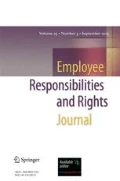Abstract
This article reports the results of two studies examining some factors that increase the likelihood that employees will voice to their supervisors. The way employees perceive that their supervisors manage employee voice was identified as a major cause of the likelihood that employees will voice upward. The Supervisor as Voice Manager Scale is presented along with data demonstrating its reliability and validity. Theoretical and applied implications of the results are discussed.
Similar content being viewed by others
References
Ajzen, I. & Fishbein, M. (1980).Understanding Attitudes and Predicting Social Behavior. Englewood Cliffs, NJ: Prentice-Hall.
Aram, J. D., & Salipante, P. F. (1981). An evaluation of organizational due process in the resolution of employee/employer conflict.Academy of Management Review, 6, 197–204.
Balfour, A. (1984). Five types of non-union grievance systems.Personnel, 61, 67–76.
Dalton, D. R. & Todor, W. D. (1982). Antecedents of grievance filing behavior: Attitude/behavioral consistency and the union steward.Academy of Management Journal, 25, 158–169.
Farrell, D. (1983). Exit, voice, loyalty, and neglect as responses to job dissatisfaction: A multidimensional scaling study.Academy of Management Journal, 26, 596–607.
Glauser, M. J. (1984). Upward information flow in organizations: Review and conceptual analysis.Human Relations, 37, 613–643.
Gordon, W. I. (1988). Range of employee voice.Employee Responsibilities and Rights Journal, 1, 283–299.
Graen, G. B., Liden, R. C. & Hoel, W. (1982). Role of leadership in the employee withdrawal process.Journal of Applied Psychology, 67, 868–872.
Graham, J. W., & Keeley, M. (1989) Critical issues of exit, voice, and loyalty. Unpublished manuscript, Loyola University of Chicago.
Hirschman, A. O. (1970).Exit, Voice, and Loyalty. Cambridge, MA: Harvard University Press.
Jablin, F. M. (1979). Supervisor-subordinate communication: The state of the art.Psychological Bulletin, 86, 1201–1222.
Joreskog, K. G., & Sorbom, D. (1978).Lisrel IV: Analysis of Linear Structural Relationships by the Method of Maximum Likelihood. Chicago: International Educational Services.
Kenny, D. (1975). Cross-lagged panel correlation: A test for spuriousness.Psychological Bulletin, 82, 887–903.
Leck, J. D. (1990). Responses to dissatisfaction and Hirschman's loyalty. Paper presented at the annual meeting of the Council on Employee Responsibilities and Rights, Orlando, Florida.
Leventhal, G. S. (1976). Fairness in social relationships. In: Thibaut, J. W., Spence, J. T. & Carson, R. C. (Eds.).Contemporary Topics in Social Psychology, 211–239. Morristown, NJ: General Learning Press.
Leventhal, G. S. (1980). What should be done with equity theory? In Gergen, K. J., Greenberg, M. S., & Willis, R. H. (Eds.).Social Exchange: Advances in Theory and Research, 27–55. New York: Plenum Press.
Likert, R. (1961).New Patterns of Management. New York: McGraw-Hill.
Lind, E. A., & Tyler, T. (1988).The Social Psychology of Procedural Justice. New York: Plenum Press.
Maccoby, E. E., Snow, M. E. & Jacklin, C. N. (1984). Children's dispositions and mother-child interaction at 12 and 18 months: A short-term longitudinal study.Developmental Psychology 20, 459–472.
McGregor, D. (1960).The Human Side of Enterprise. New York: McGraw-Hill.
Minton, J. W. (1988). Justice, satisfaction, and loyalty: Employee withdrawal and voice in the din of inequity. Unpublished dissertation, Duke University.
Mowday, R. T., & Steers, R. M. (1979). The measurement of organizational commitment.Journal of Vocational Behavior, 14, 224–247.
Nunnally, J. C. (1978).Psychometric Theory New York: McGraw-Hill.
O'Reilly, C. A., & Pondy, L. R. (1979). Organizational communication. In Kerr, S. (Ed.),Organizational Behavior. Columbus, OH: Grid.
Rogosa, D. (1980). A critique of cross-lagged correlation.Psychological Bulletin 88, 245–258.
Rusbult, C. E., & Farrell, D. (1983). A longitudinal test of the investment model: The impact on job satisfaction, job commitment, and turnover of variations in rewards, costs, alternatives, and investments.Journal of Applied Psychology, 68, 429–438.
Scott, W. G. (1965).The Management of Conflict. Homewood, IL: Irwin.
Smith, P. C., Kendall, L. M., & Hulin, C. L. (1969).The Measurement of Satisfaction in Work and Retirement. Chicago: Rand McNally.
Thibaut, J., & Walker, L. (1975).Procedural Justice: A Psychological Analysis. Hillsdale, NJ: Erlbaum.
Tyler, T. (1987). Procedural justice research.Social Justice Research, 1, 41–66.
Tyler, T., & Caine, A. (1981). The influence of outcomes and procedures on satisfaction with formal leaders.Journal of Personality and Social Psychology, 41, 642–655.
Tyler, T., & Folger, R. (1980). Distributional and procedural aspects of satisfaction with citizen-police encounters.Basic and Applied Social Psychology 1, 281–292.
Withey, M. J., & Cooper, W. H. (1989). Predicting exit, voice, loyalty, and neglect.Administrative Science Quarterly, 34, 521–539.
Additional information
Faculty of Management, McGill University.
Fuqua School of Business, Duke University.
Mathematics & Computer Science, Meredith College.
School of Management, Georgia Institute of Technology.
Rights and permissions
About this article
Cite this article
Saunders, D.M., Sheppard, B.H., Knight, V. et al. Employee voice to supervisors. Employ Respons Rights J 5, 241–259 (1992). https://doi.org/10.1007/BF01385051
Issue Date:
DOI: https://doi.org/10.1007/BF01385051




